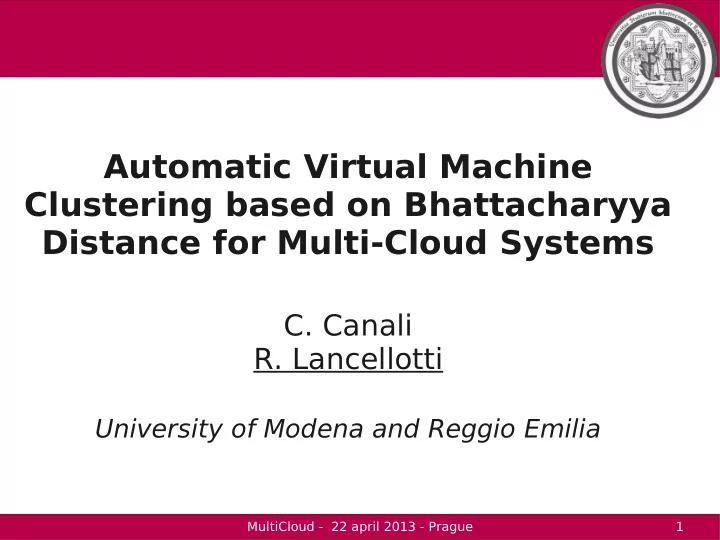

Automatic Virtual Machine Clustering based on Bhattacharyya Distance for Multi-Cloud Systems C. Canali R. Lancellotti University of Modena and Reggio Emilia MultiCloud - 22 april 2013 - Prague 1
Cloud computing challenges ● Large data centers (> 10 5 VMs) → huge amount of data ● Multiple data centers → geographic data exchange → Scalability problems ● ● Current approach reduce amount of data in a uniform way: – Reduce sampling frequency – Reduce number of metrics considered → Reduced monitoring effectiveness ● – Less information available to take management decision MultiCloud - 22 april 2013 - Prague 2
Reference scenario ● IaaS with long term commitment Geographic links ● Reactive VM relocation – Local scope – Overload mgm ● Periodic global consolidation – Global scope – Server mgm MultiCloud - 22 april 2013 - Prague 3
Impact on monitoring scalability ● Methodology: Data samples – Define quantitative model for VM (time series) behavior Extract quantitiative – Define VM similarity (dist. matrix) Model of VM behavior – Cluster similar VM together Histogram ● Elect a few (e.g., 3) cluster representatives Compute similarity between VM behavior ● Fine-grained monitoring of cluster representatives Distance matrix ● Reduced monitoring applied to other VMs Clustering – Reduced number of metrics Clustering – Lower sampling frequency solution MultiCloud - 22 april 2013 - Prague 4
Impact on monitoring scalability ● Case study: – E-health, Web-based application – Deployed on cloud IaaS ● Numeric example: – 110 VMs, K metrics, sampling frequency: 5 min. 4 K samples/day → ~3.2 10 – 2 classes, 3 rep. per class 3 K samples/day → ~2.1 10 → Monitoring data reduced ● by 1 order of magnitude MultiCloud - 22 april 2013 - Prague 5
Modeling VM behavior ● Model based on probability distribution of resource usage Data samp. – Multiple resources considered (metrics) ● Histogram for every metric, every VM VM behavior – Normalized histogram (∑h=1) Hist – B: number of buckets (critical) Similarity Dist. Mat. Clustering Clust. solution MultiCloud - 22 april 2013 - Prague 6
Defining VM similarity ● Use of Bhattacharyya distance – Determine distance matrix for each Data samp. couple of VMs, each metric VM behavior ● Euclidean combination of distance matrices Hist – Sum of squares of multiple distances Similarity Dist. Mat. Clustering Clust. solution MultiCloud - 22 april 2013 - Prague 7
Clustering algorithm ● Use of spectral clustering algorithm – Input: Square, symmetric distance Data samp. matrix VM behavior – Output: Cluster ID for every VM ● Additional feature: Hist – Number of clusters can be automatically determined through Similarity spectral gap analysis ● Open problems: Dist. Mat. – Is it correct to consider every metric Clustering together? – Is there a way to select the right Clust. solution metrics? MultiCloud - 22 april 2013 - Prague 8
Choosing the right metrics ● Multiple metrics are merged into the final distance matrix ● Not every metric provide significant information ● Proposal to identify relevant metrics – Consider auto-correlation: ACF decreasing rapidly → random variations – Consider Coefficient of Variation: CF » 1 → spiky and noisy behavior CF « 1 → little information provided → Merge information from metrics with ● – ACF decreasing slowly – CF ~ 1 MultiCloud - 22 april 2013 - Prague 9
Case study ● IaaS cloud supporting e-health – Web server and DBMS – 110 VMs – 10 metrics for each VM, – Sampling frequency: 5 min ● Goal: separate Web servers and DBMS – Main metric: Purity of clustering ● Three types of analyses – Impact of time series length – Impact of metric selection techniques – Impact of histogram characteristics MultiCloud - 22 april 2013 - Prague 10
Impact of time series length MultiCloud - 22 april 2013 - Prague 11
Impact of metric selection (1) Network I/O Mem paging # of procs. MultiCloud - 22 april 2013 - Prague 12
Impact of metric selection (2) MultiCloud - 22 april 2013 - Prague 13
Impact of histogram characteristics MultiCloud - 22 april 2013 - Prague 14
Conclusion and future work ● Scalability in (multi)cloud systems → open issue ● Proposal of novel methodology to improve scalability through clustering of similar VMs ● Experimental results are encouraging – Purity >0.83 even for very short time series ● Future research directions: – Validation with more data set (Help!) – Improving stability of the results w.r.t histogram parameters – Evaluate different models for VM behavior – Application of clustering to improve scalability of VM management MultiCloud - 22 april 2013 - Prague 15
Automatic Virtual Machine Clustering based on Bhattacharyya Distance for Multi-Cloud Systems C. Canali R. Lancellotti University of Modena and Reggio Emilia MultiCloud - 22 april 2013 - Prague 16
Recommend
More recommend